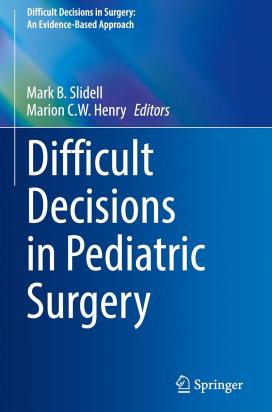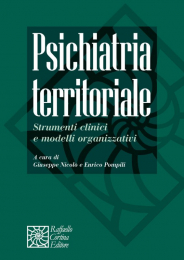Non ci sono recensioni
DA SCONTARE
Pediatric surgery is a demanding specialty that requires not only technical expertise but also exceptional clinical judgment and adaptability. Pediatric surgeons frequently encounter rare congenital anomalies and unusual surgical problems, often requiring them to make difficult decisions with limited precedent. Even well-recognized congenital conditions can present in atypical ways, necessitating a patient-centered approach that may deviate from routine practice. This places a premium on a surgeon’s ability to apply broad surgical principles to novel and complex situations, tailoring interventions to each child’s unique anatomy and pathology. Compounding this challenge is the rapidly evolving literature in pediatric surgery, where new techniques, evolving guidelines, and emerging technologies continually reshape best practices. Thoughtful interpretation of the literature is essential, particularly when the optimal approach to a problem remains unclear or controversial. Pediatric surgeons must not only stay abreast of these developments but also critically analyze and synthesize data to make sound, evidence-based decisions in the face of uncertainty.
The Difficult Decisions in Surgery series was developed to address many of these challenges faced by surgeons. To date, 10 volumes have been published, receiving enthusiastic engagement from the surgical community. These multi-authored volumes consist of concise chapters, each focused on a specific difficult or controversial decision within a surgical specialty. This series is particularly well-suited for pediatric surgeons, as it provides insight into difficult decisions faced within the field.
The volumes serve as a timely reference for practicing surgeons, trainees, and educators, emphasizing the ideal approach to selected clinical situations rather than merely reflecting customary care. Recommendations are grounded in published evidence, while also incorporating expert opinions and personal experiences, helping surgeons navigate complex, evolving literature and apply general surgical principles to novel pediatric challenges.
The chapters in each volume adhere to a specific format. This approach provides uniformity to the presentations, making it possible to identify useful material at a glance:
- a brief general introduction and description of the Difficult Decision laid out using PICO formatting·
- a brief description of the literature search process.
- a summary of available published evidence and discussion of the findings.
- the author’s personal view of the data and approach to the problem and why they do (or don’t do) things found in the presented literature.
- the chapter authors were selected from experts around the world.
- the editors for this volume were selected from among internationally renown faculty at The University of Chicago and The Johns Hopkins University.
-
Front Matter
Pages i-viii
-
Decision-Making and Implementation Science
-
Front Matter
Pages 1-1
-
Evidence Based Medicine and Decision-Making in Pediatric Surgery
- Shawn D. St. Peter
Pages 3-13
-
- KuoJen Tsao, Brittany Hegde
Pages 15-22
-
Pediatric Acute Appendicitis as a Model for Shared Decision-Making
- Lindsay A. Gil, Loren Berman, Peter C. Minneci
Pages 23-37
-
-
Trauma and Critical Care
-
Front Matter
Pages 39-39
-
Non-operative Management of Blunt Solid Organ Injuries in Pediatric Trauma
- Erin West, Pamela M. Choi
Pages 41-48
-
Optimal Management of Children with Concern for Possible Traumatic Brain Injury
- Lisandro Luques, Reto M. Baertschiger
Pages 49-65
-
- Eric A. Sribnick
Pages 67-76
-
Where Should Children Be Treated After Sustaining a Traumatic Injury?
- Matthew D. Price, Yao Li, Mark B. Slidell
Pages 77-84
-
Which Surgeons Should Care for Traumatically Injured Children in Rural Areas?
- Su Yeon Lee, Jonathan E. Kohler
Pages 85-93
-
- Travis M. Sullivan, Genevieve J. Sippel, Randall S. Burd
Pages 95-106
-
Choice of Injury Severity Scoring System in the Evaluation of Pediatric Trauma Patients
- Christopher W. Snyder, Ali A. Mokdad
Pages 107-117
-
- Kevin Johnson
Pages 119-126
-
Meaningful Survival After Neonatal ECMO: A Systematic Review of Long-Term Outcomes
- Kylie Callier, Marielena Bachier-Rodriguez
Pages 127-139
-
-
Pediatric Oncology
-
Front Matter
Pages 141-141
-
Wilms Tumor—NWTSG/COG Versus SIOP Approach Now and in the Future
- Maria Molina Mata, Israel Fernandez-Pineda
Pages 143-154
-
Rhabdomyosarcoma—Biopsy Approach
- Abigail J. Engwall-Gill, Daniel S. Rhee
Pages 155-163
-
Which Pediatric Breast Lesions Are Best Managed by Pediatric Surgeons?
- Steven T. Papastefan, Julia E. Grabowski
Pages 165-174
-
- Grace Z. Mak
Pages 175-188
-
Thoracic
-
Front Matter
Pages 189-189
-
What Is the Optimal Timing of Congenital Diaphragmatic Hernia Repair in a Neonate Requiring ECMO?
- Nikhil R. Shah, Samir K. Gadepalli
Pages 191-201
-
Pectus Excavatum—Evidence-Based Indications for Surgical Correction
- Carla M. Lopez, Clint D. Cappiello
Pages 203-213
-
What Is the Best Approach to Evaluation and Treatment of Children with Diaphragmatic Eventration?
- Brendan R. O’Connor, Warwick J. Teague
Pages 215-229
-
Spontaneous Pneumothorax: Watchful Waiting or Surgical Intervention?
- Nikhil R. Shah, K. Elizabeth Speck
Pages 231-243
-
Pleural Empyema—VATS Versus Pleural Drainage and Fibrinolysis
- Carlos Theodore Huerta, Eduardo A. Perez
Pages 245-254
-
-
Foregut
-
Front Matter
Pages 255-255
-
Management of Long-Gap Esophageal Atresia
- Anne M. Sescleifer, Shaun M. Kunisaki
Pages 257-277
-
- Amanda B. Witte, Diana G. Lerner, Dave R. Lal
Pages 279-291
-
Esophageal Replacement in Children: Optimal Approach
- Shawn Izadi, Benjamin Zendejas
Pages 293-302
-
- Kibileri Williams, Mikael Petrosyan
Pages 303-311
-
-
Abdomen and Hepatobiliary
-
Front Matter
Pages 313-313
-
- Stephen J. Hartman, Alexander J. Bondoc, Gregory M. Tiao
Pages 315-324
-
Appendicitis: Medical Management of Early Appendicitis
- Bethany J. Slater, Martin Walsh
Pages 325-332
-
- George S. Bethell, Michael Stanton
Pages 333-339
-
Do Consensus-Based Care Pathways Improve Patient Outcomes in the Management of Gastroschisis?
- Leigh Selesner, Elizabeth Fialkowski
Pages 341-357
-
Necrotizing Enterocolitis: Indications to Operate
- Daniel Scheese, Johannes W. Duess, Zachariah Raouf, David J. Hackam
Pages 359-373
-
What Is the Optimal Interval Between Ostomy Formation and Ostomy Takedown in a Newborn After NEC?
- Erica Hodgman, Jessica A. Zagory
Pages 375-387
-
Intussusception Management: Can We Do Better?
- Carmelle Romain, Mubina Isani
Pages 389-394
-
Ladd’s Procedure in an Asymptomatic Child with Congenital Heart Disease and Heterotaxy
- Wesley E. Barry III, Kathryn J. Rowland
Pages 395-404
-
Colorectal and Genitourinary
-
Front Matter
Pages 405-405
-
- Sophia Y. Chen, Alejandro V. Garcia
Pages 407-428
-
- Laura Tiusaba, Christina Feng
Pages 429-439
-
Anorectal Malformations- Who Should Perform the Repair?
- Rebecca M. Rentea, Caitlin A. Smith
Pages 441-455
-
Pull-through in the Setting of Cloacal Exstrophy
- Ahmad Haffar, Chad Crigger, Isam W. Nasr
Pages 457-464
-
Undescended Testes: Timing of Orchidopexy
- Shareena Lala, Kimberly Aikins, Philip Morreau
Pages 465-488
-
-
Pediatric Surgery in Resource-Constrained Settings
-
Front Matter
Pages 489-489
-
Management of Anorectal Malformations and Hirschsprung’s Disease in Resource Challenged Settings?
- Chris Westgarth-Taylor, Justina O. Seyi-Olajide, Benedict C. Nwomeh, Richard Wood
Pages 491-505
-
- Sarah Muma, Muma J. K. Nyagetuba, Erik Hansen
Pages 507-513
-
Ethical Dilemmas in Global Pediatric Surgery
- Felix Oyania, Tamara N. Fitzgerald, Anthony Eze
Pages 515-531
-
-
Special Areas
-
Front Matter
Pages 533-533
-
Selection of the Next Generation of Pediatric Surgery Trainees: Best Practices and Best Outcomes
- Mollie R. Freedman-Weiss, Samuel M. Alaish
Pages 535-546
-
- Johnathan Kent, Miranda Ortega, Manish Tushar Raiji
Pages 547-558
-
Is It Ethically Permissible to Prioritize Pediatric Patients for Scarce Surgical Resources?
- Erica M. Carlisle
Pages 559-567
-
Changing Postoperative Opioid Prescribing Practices
- Olivia A. Keane, Lorraine I. Kelley-Quon
Pages 569-584
-
-
-




